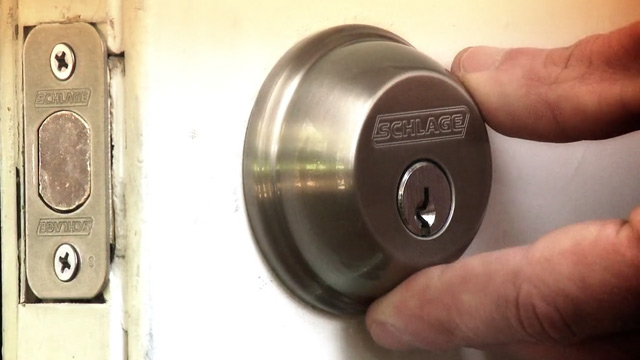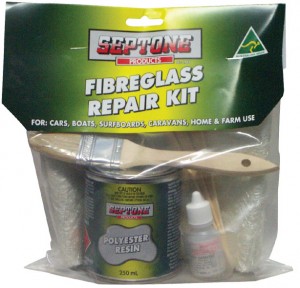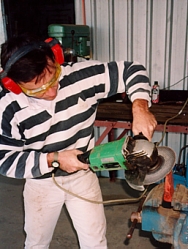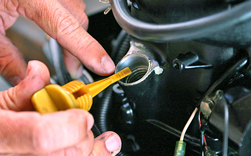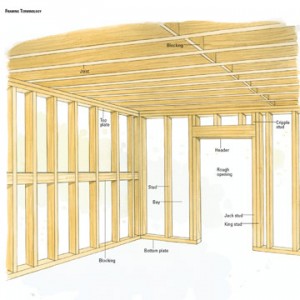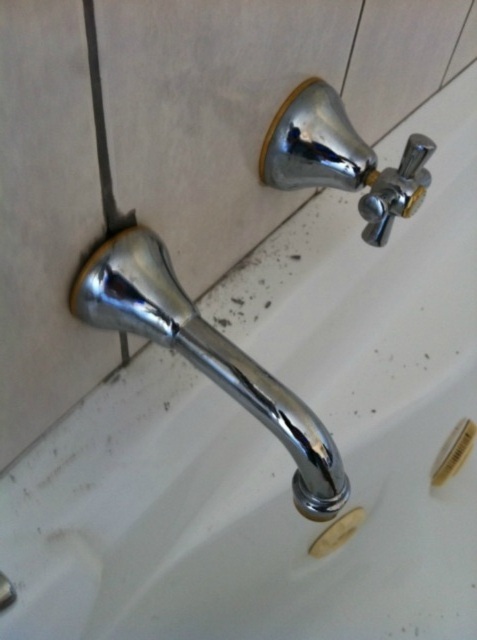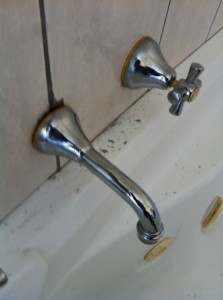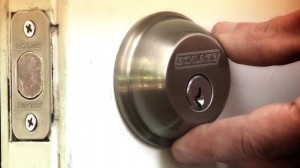
Two of the most common locks which can be installed by a home handyman are the mortise lock, which is recessed into the face of the door; and rim locks, mounted on the face of the door. For security, both locks should feature a deadlock mechanism, which triggers the lock automatically when the door is closed so only the key can open the lock from either side of the door. This means if the door has glass panels no-one can open the door by reaching through a broken pane. It also means anyone entering through another access cannot use the main door to carry away your possessions and may well leave empty-handed rather than be seen passing goods through a window.
Fixing a cylinder rim dead latch.
If the door already has a mortise lock, which you wish to retain, position the new lock above it at about shoulder height. If the new lock is a replacement, remove the old lock and fill in the old mortise with wood, glued and sanded back. Then position the new lock slightly above the door centre. The new lock will come with a paper diagram called a template, which shows where to drill the required holes. Place the paper template against the inside of the door, with the edge line even with the edge of the door. Punch through the diagram to indicate where to locate cylinder, and screw holes. Drill the cylinder hole using a hole saw attachment the same diameter as the lock cylinder. Next, slip the cylinder ring over the cylinder and insert into door. The connecting bar is designed so it can be shortened to suit different door thickness. Follow the manufacturer’s instructions to obtain the right amount of projection. Remove the cover plate from the lock and fix to the door with wood screws. Take the key out of the lock and insert cylinder and ring assembly into door. Make sure the connecting bar enters the lock mechanism. Fix the cylinder in place with connecting screws fitted through the top pair of holes in the cover plate. Try the key in the cylinder. If it does not turn freely, check that the connecting bar is correctly shortened.
Attach the lock case to the cover plate and screw into position.
Line up the striker plate (also called the staple) with the lock assembly. Using the plate as a pattern, mark the jamb where it is to be mortised, and cut the mortise. Using a mortise chisel makes this job easier. Mark the screw positions and fix the staple onto the jamb so it sits flush with the jamb.
Mortise locks.
Mortise locks are recessed into the face of the door. There are a number of different types such as claw bolt design for sliding doors, deadlocking types suitable for security screen doors and narrow designs for aluminium section doorframes. Most are installed in a similar way.
Place the lock against the edge of the door and mark where the handle bar and keyhole are to go. Allow for recessing the faceplate into the door. Mark a centre line down the depth of the door, the same depth as the lock and bore mortise holes the length of the lock. Use a chisel to cut out the mortise. Bore holes in the door where you have marked the position of handle and keyhole. Insert the lock in the mortise and mark the position of the faceplate on the inside of the door. Chisel out this outline to take the faceplate and mark holes for the faceplate screws. Fasten the lock mechanism in place, fit the handle bar through the lock and mark where door furniture is to go (handles and knobs). Fit these. Close the door and locate the position for the striker plate so this will line up with the lock mechanism. Using the plate as a pattern, mark the two recesses where latch and bolt enter and cut out enough wood to accommodate them. Screw the striker plate into position.
Key in knob locks.
This type of lock is decorative as well as functional. It comprises a locking mechanism, an inner doorknob and an outer knob, which includes the keyhole. Some types incorporate an automatic dead latching mechanism so only the key can move the bolt. Other styles, commonly called privacy latches, include a turn button, which locks or unlocks the door from inside. Sometimes a key can still open this lock from the outside. Various styles can be purchased to be operated with a key from the outside only or by key from both sides. Various decorative trims and finishes are available to suit different decorating schemes. To install most such locks you only need to drill two holes, one on the inside, one on the outside face of the door, and cut a recessed panel to take the latch face plate, with a corresponding recess in the jamb to take the striker plate.
Other security devices.
A stout lock on the main entrance is your best defence against intrusion. But there are times when you must open the door. Minimise risk by installing a chain device so you can talk to callers through a small opening. Some chains include an alarm device, which sounds if an attempt is made to force the door.
Securing windows, garage doors and other points of entry is also easier with new kinds of locking bolt devices which can be fitted to these and many other problem areas, including caravans. For other danger zones around your home, such as the gate leading to a swimming pool enclosure, there are specially designed safety catches and hinges which cannot be manipulated by young children, but are easy for stronger people to use. Features such as automatic closing ensure security gates cannot be left open accidentally.
Materials you’ll need:
- New lock and instructions
- Wood filler or putty Wood glue Sandpaper
Tools you’ll need:
- Drill with hole saw attachments
- Screwdriver
- Mortise chisel
- Woodworking chisel
